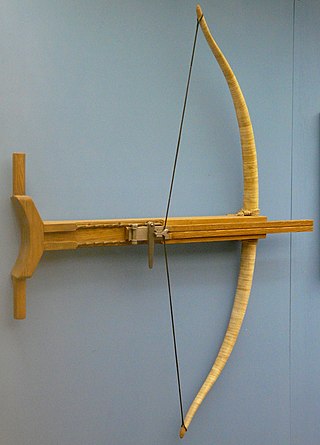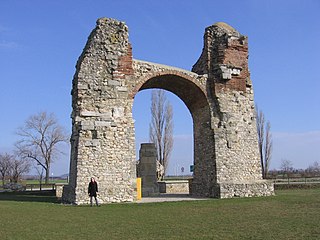
Acinonyx is a genus within the Felidae family. The only living species of the genus, the cheetah, lives in open grasslands of Africa and Asia.

Georg Friedrich Puchta was a German Legal scholar.

Christian Karl Friedrich Hülsen was a German architectural historian of the classical era who later changed to studying the Middle Ages and the Renaissance.

Legio XI Claudia was a legion of the Imperial Roman army. The legion was levied by Julius Caesar for his campaign against the Nervii. XI Claudia dates back to the two legions recruited by Julius Caesar to invade Gallia in 58 BC, and it existed at least until the early 5th century, guarding lower Danube in Durostorum.

The gastraphetes, also called belly bow or belly shooter, was a hand-held crossbow used by the Ancient Greeks. It was described in the 1st century AD by the Greek author Heron of Alexandria in his work Belopoeica, which draws on an earlier account of the famous Greek engineer Ctesibius. Heron identifies the gastraphetes as the forerunner of the later catapult, which places its invention some unknown time prior to c. 420 BC.

Barbaricum is a geographical name used by historical and archaeological experts to refer to the vast area of barbarian-occupied territory that lay, in Roman times, beyond the frontiers or limes of the Roman Empire in North, Central and South Eastern Europe, the "lands lying beyond Roman administrative control but nonetheless a part of the Roman world". During the Late Antiquity, it was the Latin name for those tribal territories not occupied by Rome that lay beyond the Rhine and the Danube : Ammianus Marcellinus used it, as did Eutropius. The earliest recorded mention appears to date to the early 3rd century.
Joseph Vogt was a German classical historian, one of the leading 20th-century experts on Roman history.

Diana Veteranorum, today a village called Ain Zana, was an ancient Roman-Berber city in Algeria. It was located around 40 km northwest of Lambaesis and 85 km southwest of Cirta.
The Imperial Military Constitution was the collection of military laws of the Holy Roman Empire. Like the rest of the imperial constitution, it grew out of various laws and governed the establishment of military forces within the Empire. It was the basis for the establishment of the Army of the Holy Roman Empire, which was under the supreme command of the Emperor but was distinct from his Imperial Army, as it could only be deployed by the Imperial Diet. The last Imperial Defence Order (Reichsdefensionalordnung), entitled Reichsgutachten in puncto securitatis, of 13/23 May 1681, completed the military constitution of the Holy Roman Empire.
Hans Beck is a German and Canadian scholar in the field of Classical Studies.

A burgus or turris ("tower") is a small, tower-like fort of the Late Antiquity, which was sometimes protected by an outwork and surrounding ditches. Darvill defines it as "a small fortified position or watch-tower usually controlling a main routeway."

The Roman fort at Weissenburg, called Biriciana in ancient times, is a former Roman ala castellum, which is a UNESCO World Heritage Site located near the Upper Germanic-Rhaetian Limes. It lies in the borough of Weißenburg in the Middle Franconian county of Weißenburg-Gunzenhausen in Germany. Today the castellum is one of the most important sites of research in the Roman limes in Germany. The site contains partly subterranean building remains, a reconstructed north gateway, large thermal baths and a Roman Museum with an integrated Limes Information Centre.

The Lower Germanic Limes is the former frontier between the Roman province of Germania Inferior and Germania Magna. The Lower Germanic Limes separated that part of the Rhineland left of the Rhine as well as the southern part of the Netherlands, which was part of the Roman Empire, from the less tightly controlled regions east of the Rhine.

The Neckar-Odenwald Limes is a collective term for two, very different early sections of the Upper Germanic-Rhaetian Limes, a Roman defensive frontier line that may have been utilised during slightly different periods in history. The Neckar-Odenwald Limes consists of the northern Odenwald Limes (Odenwaldlimes), a cross-country limes with camps, watchtowers and palisades, which linked the River Main with the Neckar, and the adjoining southern Neckar Limes (Neckarlimes), which in earlier research was seen as a typical 'riverine limes', whereby the river replaced the function of the palisade as an approach obstacle. More recent research has thrown a different light on this way of viewing things that means may have to be relativized in future. The resulting research is ongoing.

The Pannonian Limes is part of the old Roman fortified frontier known as the Danubian Limes that runs for approximately 420 km (260 mi) from the Roman camp of Klosterneuburg in the Vienna Basin in Austria to the castrum in Singidunum (Belgrade) in present-day Serbia. The garrisons of these camps protected the Pannonian provinces against attacks from the north from the time of Augustus (31 BC–14 AD) to the beginning of the 5th century. In places this section of the Roman limes also crossed the river into the territory of the barbarians (Barbaricum).
Pfünz Roman Fort, Castra Vetoniana or Vetonianae, was a Roman cohort camp near Pfünz, a village in the municipality of Walting in the county of Eichstätt, Bavaria. It was built in about 90 A. D. on a 42-metre-high Jurassic hillspur between the valley of the Altmühl and that of the Pfünzer Bach stream. it is a component of the Rhaetian Limes which was elevated in 2005 to the status of a UNESCO World Heritage Site. Of historical importance are the remains of the double V-shaped ditches hewn out of the rock in front of the position, the one on the western rampart being the best preserved. In 1998, as part of the construction of a high pressure water system, the Bavarian State Office for Monument Protection carried out further test excavations. The archaeological record and rich finds from Pfünz, some of which are very rare, are seen as reasons for further studies in the future.
The Main Limes, also called the Nasser Limes, was built around 90 AD and, as part of the Upper Germanic-Rhaetian Limes, formed the frontier of the Roman Empire in the area between the present day villages of Großkrotzenburg and Bürgstadt. In this section the limes adjoined the River Main (Moenus), which forms a natural boundary for about 50 kilometres here, so "Main" refers to the river.
Maria Radnoti-Alföldi was a Hungarian-German archaeologist and numismatist specialising in the Roman period. She is known for her research into the analysis of the distribution of coin finds, Roman history, and the self-depiction of the Roman emperors.

Legio I Flavia Constantia was a Roman legion, mentioned in the Notitia Dignitatum as a comitatenses unit stationed in the Eastern Empire.














